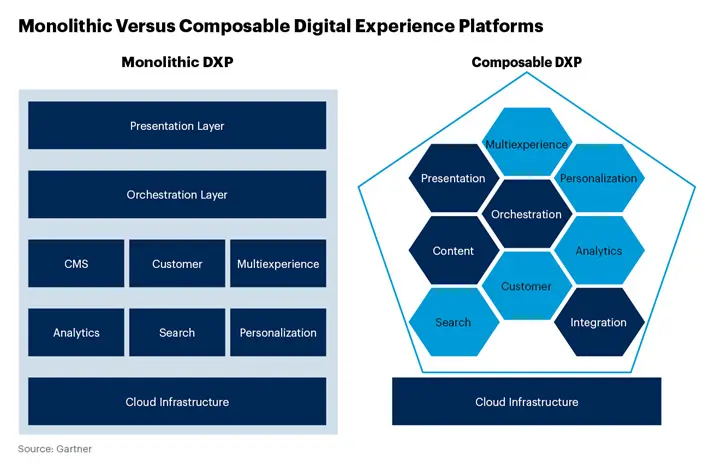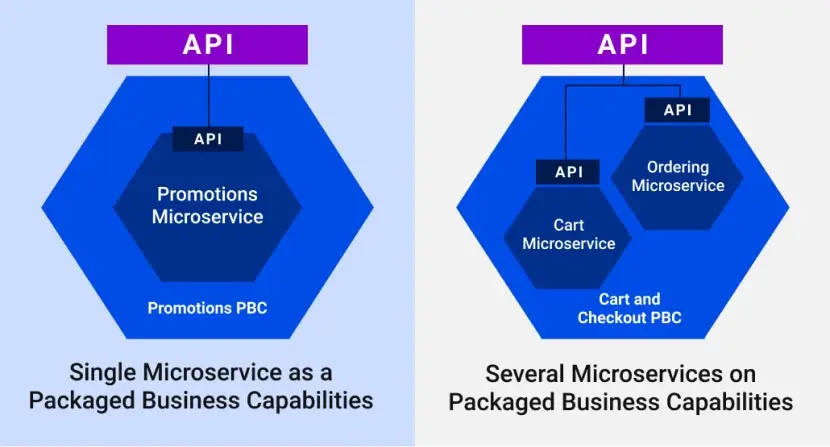Composable commerce: everything you need to know
10-03-2023

In recent years, the world of eCommerce has evolved at lightning speed. Traditional monolithic eCommerce platforms no longer meet the needs of modern businesses. This is where composable commerce comes in as a potential gamechanger.
Composable commerce is a new approach to building eCommerce platforms that makes it possible to create a customized, flexible and scalable solution using independent and reusable commerce services. These services can include everything from a product catalog, inventory management, payments and shipping to customer experience management and marketing automation.
Unlike traditional eCommerce platforms, which tend to be built as a single block with tightly integrated components that are difficult to customize, composable commerce uses modular and independent services that you can combine according to (current) needs. This approach makes it easier to align your eCommerce with current market developments and adapt to changing customer needs.
In this blog, we take a closer look at composable commerce and the benefits of the technology, such as improved flexibility, cost savings and better customer experiences. We also look at some of the key components of composable commerce and show how companies can successfully adopt this approach to drive growth and success within the modern eCommerce landscape.
Composable commerce involves selecting eCommerce components according to the best-of-breed principle and bundling those functionalities into a custom solution. You use modern technologies and approaches such as MACH (microservices, APIs, cloud and headless) and Jamstack (JavaScript, APIs and Markup) to quickly respond to erratic market dynamics. The modular architecture means that each component is pluggable, scalable and replaceable at any time. And all without affecting the other parts of the application.
For example, an online store using composed commerce might use one solution for processing payments, another for sending and managing subscriptions, and yet another for adding content to the website. Although all of these functionalities come from different vendors, the customer experiences them as part of a single, streamlined solution.

The core idea behind composable commerce? Giving brands, vendors and their developers the ability and flexibility to adapt to technological novelties and behavioral changes within their customer base. Developers can select and assemble a custom solution that fits their specific needs.
The term "composable commerce" was first popularized by Gartner in 2020. In a report, Gartner predicts that organizations that adopt a "composable" approach will be about 80 percent faster than the competition in implementing new functionality. Moreover, 95 percent of eCommerce professionals believe that composable commerce is the right and most future-proof approach.
There is, however, a clear distinction between microservices and the packaged business capabilities (PBC) of composable commerce. While microservices represent breaking down an application into small functionalities, PBCs are intentionally grouped sets of functions and features.
The modern vision of composable commerce is based on several key principles:
Composable commerce is an approach to eCommerce where companies combine different technologies, services and functionalities to create a customized eCommerce solution that fits their specific needs. Packaged business capabilities (PBCs) are part of this approach because they allow companies to quickly and efficiently add the features they need to expand their eCommerce operations.
Packaged business capabilities can include, for example, functions such as product catalog management, payment processing, customer service, order management and marketing automation. You can purchase these functionalities as modules and integrate them into a company's existing eCommerce architecture. This allows organizations to respond quickly and flexibly to changing customer needs and market trends.

MACH, an acronym that stands for the combination of microservices-based, API-first, cloud-native SaaS and headless, is a modern technology stack that supports composable commerce. The combination of these technologies are designed to help companies build freely composable, flexible and scalable commerce systems. These have the ability to keep up with the rapidly changing needs of the modern eCommerce landscape.
To show all that MACH can bring, it is time to briefly discuss its individual elements one by one.
Headless is also popular in the world of eCommerce. Headless and composable commerce are very similar (in both cases, you disconnect the frontend from the backend) and rely on APIs for communication between components. Both of these approaches focus heavily on flexibility and adaptability. However, they are certainly not synonyms.
Headless commerce is an approach where you decouple the frontend (the user interface that customers see) and backend (the underlying systems that provide the functionality) of a platform. The benefit of that approach? You can customize the frontend without having to change the backend. Companies can build their own custom Web shop, mobile app or IoT applications and integrate them with the backend. Headless commerce offers flexibility and customization for the frontend, while the backend is usually a monolithic system.
Composable commerce goes one step further than headless. This is because you now have a system where all components of the eCommerce platform (including the backend) are modular. Selecting and combining modules independently is no problem at all. This way you can easily build a customized eCommerce stack that fits your specific needs. With composable commerce, the front and backend are both fully customizable.
Flexibility and adaptability are important principles of both headless and composable commerce. However, composable commerce goes a step further by allowing users to configure all components of the eCommerce platform in a modular way.
Many companies arguing the added value of composable commerce believe that this option offers enough flexibility to work with information quickly. This allows them to perform better than competitors and offer their customers plenty of convenience.
Statistics show that fewer and fewer people begin their buying journey with a search machine. Today, social media drives virtually every aspect of online buying. This situation requires flexibility. In the early days of eCommerce, that was often simply not there. Composable commerce does fill that need.
The ability to adapt quickly and efficiently is required if you are to respond appropriately to unexpected events and issues (think COVID-19). A modular, best-in-breed strategy provides the best opportunities to do this and prevents changes from negatively impacting other business opportunities within your digital ecosystem.
With composable commerce, you build the application that you really need. There are no two companies that are the same. This means they shouldn't have the same eCommerce solution, either. With composable commerce, companies combine different technologies, services and functionalities to create a customized eCommerce solution that fits their specific needs. They can quickly add or remove new features as their customers' needs and market trends change.
When you're just starting out, a traditional and generic eCommerce platform often meets your needs just fine. But when you want to grow, you want to be able to add functionality quickly, easily and as you want. A composable commerce application provides that capability and easily grows with your business requirements.
Is composable commerce the right choice for your business? The answer to that question depends on several factors. Consider the size of the company, the complexity of eCommerce operations, the degree of flexibility desired and the technical expertise available. Composable commerce is especially ideal for companies that need a flexible and scalable eCommerce solution. The modular nature of composable commerce allows companies to customize and expand the various components of their eCommerce landscape without disrupting the entire system.
Besides the obvious advantages, composable commerce also has some potential drawbacks. These are mainly in the areas of technology and adoption. This is because if you choose composable commerce, you must have the necessary technical expertise internally to integrate and manage the various components of the system.
Since composable commerce often uses a MACH architecture, sufficient knowledge of cloud computing and APIs is also essential if you want to use the technology effectively. Does a company lack the necessary technical expertise or resources? Then implementing composable commerce is often a precarious job and costly choice. Lacking the necessary technical expertise, a traditional, monolithic eCommerce platform may be a better option.
In short, composable commerce is especially attractive to companies that need a high degree of flexibility and scalability in their eCommerce operations. But it remains important to carefully weigh the pros and cons and assess whether the organization has sufficient technical expertise to manage the system effectively.
Why you should build a varied and inspiring customer journey for online success